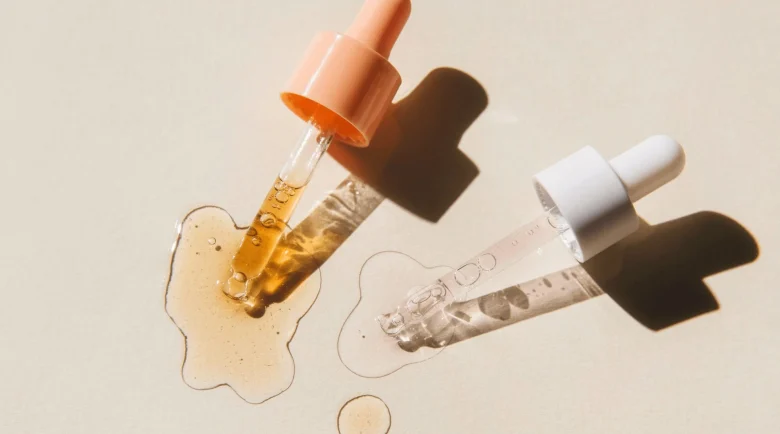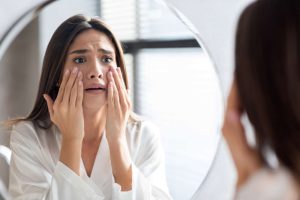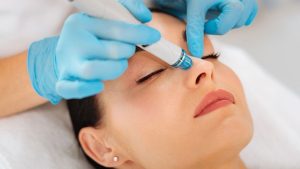Acne is a challenge that touches almost everyone’s life. It takes many forms, from mild cases to severe cystic acne, and picking the right treatment can be both daunting and tiring. Some of the most common and effective treatments out there use salicylic acid and benzoyl peroxide as their main ingredients. These two acids are common in over-the-counter products and are popular for use amongst dermatologists. These products typically have different approaches to tackling acne; however, each ingredient has its own distinct advantages that cater to particular skin types and issues. Salicylic acid and benzoyl peroxide differ fundamentally in their underlying structure, and knowing these differences can greatly assist in targeting particular concerns for prevention and treatment of acne.
Acne and How Salicylic Acid Works
Salicylic acid is a BHA considered to be an acid with exfoliating capabilities that aids in unclogging pores. Salicylic acid works in many ways; to start with, it penetrates the skin’s pores to unclog them by dissolving the excess oils deep in the affected area. It also scrubs off dead skin cells that can block the pores and trigger breakouts. Salicylic acid not only removes blemishes at the surface level but also makes sure to clean pores in an effective manner. It is especially effective for blackheads and whiteheads, as it clears out impurities and reduces inflammation. And it doesn’t stop there. Salicylic acid works wonders with continual usage while refining skin texture, reducing the size of pores, and ensuring a much smoother glow.
How Benzoyl Peroxide Works with Acne Treatment
Benzoyl peroxide is an antibacterial agent that stops the growth of acne-causing bacteria that is known as Propionibacterium acnes (P. acnes). Unlike salicylic acid, which is only focused on exfoliation, benzoyl peroxide is more versatile in that it kills skin bacteria and reduces inflammation at the same time. It also removes excess oil and reduces the chances of pores getting clogged. This is why it is highly effective against inflammatory acne: red pimples, pustules, and cystic breakouts. Benzoyl peroxide is provided in varying strengths for the users to select the level that is right for them based on the intensity of their acne. It is known for having rapid results, but if not used properly, it can dry the skin.
Choosing Between Salicylic Acid and Benzoyl Peroxide
Deciding which one to use—salicylic acid or benzoyl peroxide—is determined by the type of acne one has coupled with how sensitive one’s skin is. Individuals suffering from mild to moderate acne, blackheads, and whiteheads will benefit from salicylic acid’s gentle action. Salicylic acid works well for oily and combination skin types. Salicylic acid is also helpful for cell turnover, which makes it beneficial for individuals dealing with post-acne marks and uneven skin tone. Benzoyl peroxide, on the other hand, is more effective for moderate to severe inflamed acne, cystic deep pimples, and inflamed cysts. It is more aggressive in treating breakouts and works best on acne lesions often but can also cause inflammation as a side effect if used too frequently or at higher concentrations.
Possible Side Effects Induced by Salicylic Acid
Even though salicylic acid is perceived as a mild compound, greater concentrations and prolonged usage can result in excessive dryness and peeling. Depending on the user’s skin type, some may also experience redness and sensitivity. To avoid drying the skin too much, it’s preferable to use the highest concentrations only after the skin has acclimatised to salicylic acid. When employing salicylic acid, hydrating skin moisturisers can help in retaining the skin moisture. Salicylic acid makes the skin more sensitive to sunlight, so sunscreen should definitely be worn on a daily basis if incorporating salicylic acid into the skincare routine.
The Risks and Considerations When Using Benzoyl Peroxide
While effective in acne treatment, benzoyl peroxide tends to be overaggressive for the skin, especially for sensitive and dry skin types. As with any new product, introducing it into a routine can cause excessive dryness, peeling, and redness of the skin. One major drawback of benzoyl peroxide is the fact that it can stain practically any material, which includes towels and pillowcases. For mild skin irritation, using a lower concentration of benzoyl peroxide cream and using a moisturiser after can be most efficient. One way to ensure greater effectiveness for those with sensitive skin is to use benzoyl peroxide on trouble spots only. Just like with salicylic acid, the use of sunscreen is a must because of enhanced sensitivity to sunlight.
Salicylic Acid and Benzoyl Peroxide with Reinforcement
Certain people with persistent acne might think of incorporating both salicylic acid and benzoyl peroxide in their acne treatment regimen. While it can be effective, it should be used with caution. Utilising both substances simultaneously may intensify the possibility of irritative effects and increased dryness and sensitivity of the skin. To avoid rubbing in the salve too deep, one approach is to schedule salicylic acid use in the morning and benzoyl peroxide application at night. In another way, salicylic acid can be employed on the skin areas with blackheads or whiteheads, and benzoyl peroxide may work as a host inflammatory acne. Adequate treatment of dryness and other soothing agents such as niacinamide or hyaluronic acid can help harmonise the skin while using ozone therapy.
What Is Superior for Various Skin Types?
Using salicylic acid as compared to benzoyl peroxide will vary depending on the type of skin a person has. Salicylic acid benefits individuals with oily skin as it helps in controlling sebum production and aids in unclogging the pores. Additionally, combination skin can employ salicylic acid for its T-zone while attending to other parts of the face with moisturiser. On the contrary, people suffering from sensitive or dry skin are advised to be careful with benzoyl peroxide, as it can be too strong, leading to irritation. For acne-scar-susceptible skin that is also reactive in nature, it is best to begin with small doses of benzoyl peroxide or use it as a gel and abstain from overdosing it to limit excessive dryness.
The Importance of Uniformity in Managing Acne
It is emphasised that salicylic acid or benzoyl peroxide should be applied consistently if one wants to treat their acne effectively. Always remember, both of the components take time to come into effect, so results will not be immediate. Notable changes can take a few weeks, so one will have to stay patient. Stopping treatment abruptly can lead to the resurgence of breakouts since acne is a condition that needs chronic treatment. A well-planned skincare routine using mild cleansers and moisturisers, along with sunscreen, can also help acne treatment work more effectively. Skin that is over-exfoliated, or too many harsh ingredients are applied in the removal of acne, can worsen the condition.
Conclusion
Both salicylic acid and benzoyl peroxide are potent acne solution ingredients; however, their applications vary considerably. Salicylic acid is best at preventing the formation of blackheads through pore unclogging and mild skin exfoliation. It also works best on people with moderate acne and oily or combination skin. Alternatively, benzoyl peroxide is best known for being an antibacterial treatment that soothes inflammatory acne by reducing redness and irritation. Although effective, it can be very drying, so caution is advised. The decision on which product to choose should be based on the kind of acne, the patient’s skin type, and the patient’s tolerance. With proper care products, both salicylic acid and benzoyl peroxide will give the patient healthier and clearer skin.
FAQs
1. Which is the better technique for severe acne?
People suffering from severe, inflamed acne are better off using benzoyl peroxide, as it destroys acne’s bacterial roots and inflammation as well.
2. Does benzoyl peroxide bleach clothing?
Indeed, benzoyl peroxide does have fabric bleaching capabilities. This includes towels and pillowcase covers. It is best to use white linens or, if one applies care, coloured ones.
3. How long does it take to see the results?
Results may take time, but considering consistent use, improvements are usually noticed around four to six weeks.
4. Am I able to use Benzoyl Peroxide on a daily basis?
Yes, those with sensitive skin should start with a lower percentage as they ramp up frequency to prevent irritation.
5. Is sunscreen a requirement when using these ingredients?
Yes, salicylic acid and benzoyl peroxide are known for increasing sun sensitivity; therefore, wearing sunscreen every day is a must in order to protect the skin.




